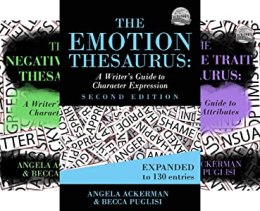Most authors who have been in writing groups for any length of time become adept at writing emotions on a surface level. We bandage our wounded egos and work at showing our characters’ inner demons. We spend hours writing and rewriting, forcing words into facial expressions.
 Happiness, anger, spite – all the emotions get a description. Eyebrows raise or draw together; foreheads crease and eyes twinkle; shoulders slump and hands tremble. Lips turn up, lips curve down, and eyes spark – and so on and so on.
Happiness, anger, spite – all the emotions get a description. Eyebrows raise or draw together; foreheads crease and eyes twinkle; shoulders slump and hands tremble. Lips turn up, lips curve down, and eyes spark – and so on and so on.
Using facial expressions as dialogue tags can work when done sparingly and combined with a conversation.
But that solution can easily become a crutch that keeps us from delving deeper into our characters.
Also, it’s aggravating when it becomes repetitive.
And this brings me to the core of this post. In the early drafts of my most recent work in progress, I struggled to give my characters balanced personalities. During NaNoWriMo, when I was writing new words as quickly as I could, I leaned too heavily on the external, with a LOT of smiling and shrugging.
Those facial expressions were code words for the second draft, places where more work would be required to flesh out the scene.
Nothing is more ordinary than a story where a person’s facial expressions take center stage, hollow displays of emotion with no substance. Lips stretch into smiles, but the musculature of the face is only a small part of the signals that reveal the character’s interior emotions.
Then, there are the stories where the author leans too heavily on the internal. Creased foreheads are replaced with stomach-churning, gut-wrenching shock, or wide-eyed trembling of hands.
And don’t forget the recurring moments of weak-kneed nausea.
 For me, the most challenging part of writing the final draft of any novel is balancing the visual indicators of emotion with the more profound, internal clues.
For me, the most challenging part of writing the final draft of any novel is balancing the visual indicators of emotion with the more profound, internal clues.
It takes effort to write a narrative so that we aren’t telling the reader what to experience. We allow the reader to infer what to feel (remember we are still in the inferential layer of the Word-Pond). We must make the emotion feel as if it is the reader’s idea.
If you haven’t seen this before, here is my list of surface emotions:
- Admiration
- Affection
- Anger
- Anguish
- Anticipation
- Anxiety
- Awe
- Confidence
- Contempt
- Defeat
- Defensiveness
- Denial
- Depression
- Desire
- Desperation
- Determination
- Disappointment
- Disbelief
- Disgust
- Elation
- Embarrassment
- Ethical Quandary
- Fear
- Friendship
- Grief
- Happiness
- Hate
- Inadequacy
- Indecision
- Interest
- Jealousy
- Love
- Lust
- Powerlessness
- Pride
- Regret
- Resistance
- Revulsion
- Sadness
- Shock
- Surprise
- Temptation
- Trust
- Unease
- Weakness
These are emotions you can show with either a facial expression or a physical reaction, combined with internal dialogue or conversations.
 I have mentioned The Emotion Thesaurus by Angela Ackerman and Becca Puglisi. Sometimes all we need is a hint of how to show what a character is feeling, someone to point the way when we’re suffering from a blank mind.
I have mentioned The Emotion Thesaurus by Angela Ackerman and Becca Puglisi. Sometimes all we need is a hint of how to show what a character is feeling, someone to point the way when we’re suffering from a blank mind.
Just don’t go overboard when describing emotions, as it can turn into mawkishness, maudlin caricatures of emotions, and over-the-top melodrama.
Readers form mental visions of the scenes you describe, and you don’t want them to find your protagonist’s reactions repulsive.
A few subtle physical hints and some internal dialogue laced into the narrative show a rounded character, one who is not mentally unhinged.
Each of us experiences emotional highs and lows in our daily lives. We have deep-rooted, personal reasons for our emotions. Our characters must have credible reasons, too. A flash of memory or a sensory prompt can inspire emotions that a reader can empathize with.
Why does a blind alley or a vacant lot make a character nervous?
Why does a grandmother hoard food?
Why does the sight of daisies make an old woman smile?
Writing genuine emotions requires practice and thought. Motivation is the foundation of emotion in a narrative. If a character’s eyes light up at the sight of daisies, WHY does she react with that emotion?
Emotions that are undermotivated have no base for existence, no foundation. They lack credibility and leave us, the reader, feeling as if the story is shallow, a lot of noise about nothing.
Timing and pacing are essential. Let’s say the sight of a river sparks a memory.
The emotion hits, and the character processes it, experiencing a physical reaction.
If something sparks a memory that advances the plot or explains something about the character, simply mention it in passing. That way, you avoid dumping backstory, and the reader can extrapolate the needed information.
 Open the thesaurus and find words that carry visual impact in your narrative, and you won’t have to resort to a great deal of description.
Open the thesaurus and find words that carry visual impact in your narrative, and you won’t have to resort to a great deal of description.
Weak word choices separate the reader from the experience of the narrative, dulling the emotional impact of what could be a highly charged scene.
Balancing the internal and external reactions our characters experience is necessary. Otherwise, all we have is a bunch of drama queens on a quest for sanity instead of heroes looking to rid the world of evil.
The books I love are written with bold, strong words and phrasing. The emotional lives of their characters are real and immediate to me. Those are the kind of characters that have depth and are memorable.
Homework assignment: A good exercise for writing deep emotions is to create scenes involving characters you currently have no use for.
 The setting is a coffee shop.
The setting is a coffee shop.- You must create two to four characters.
- One of them is hiding a gun.
- One of them is angry.
- Give them conversations and mental dialogue and practice using their body language instead of dialogue tags.
Mixing body language into paragraphs in place of dialogue tags to show who is speaking serves several purposes:
- It describes what they are thinking and feeling in fewer words.
- It keeps the “he said, they said” problem down to a dull roar.
Again, common sense is required, or the scene becomes nothing but words followed by grimaces, foot shuffling, and paper rattling.
Remember, just as in all the many other skills necessary to the craft of writing a balanced narrative, practice is required.
PREVIOUS POSTS IN THIS SERIES:
Storyboarding character development








Lol, gut-churning nausea and thumping hearts abound in my first draft. Two thirds of them get pruned out in the first edit, and those left are refined in the the next pass.
Only one reviewer so far has accused me of melodrama in the finished product, thank goodness, but I pity my poor writer’s group who have to suffer through my first draft!
LikeLiked by 1 person
I have the exact opposite problem in my first drafts. They just stand around smiling, lol.
LikeLiked by 1 person
Another excellent class in fine writing. Thank you!
LikeLiked by 1 person
Thank you for the kind words, Ellen! I learn from my writing posse. 😀
LikeLike
Pingback: Character Development: Showing Emotions | WATERSPELL
Thank you for the reblog!
LikeLike
Reblogged this on Chris The Story Reading Ape's Blog.
LikeLiked by 1 person
❤ Thank you, Chris ❤
LikeLiked by 1 person
Welcome, Connie 🤗
LikeLike
This can be a bit of an obstacle course. Facial expressions and eyes rolling, crawling, and darting aren’t good options. Words ending in -ly tacked onto dialogue tags are out. “Felt” is a filter word. Churning guts can be tedious, especially if described at length. What’s a writer to do?
What books do you think show character emotions effectively?
LikeLike
Hello! It is an obstacle course in a way, but I think we just try to write as best we can, using what we know. The books that moved me to think I could write when I was a young mother and holding three jobs were written by Anne McCaffrey (her Pern series) and also The Mists of Avalon by Marion Zimmer Bradley. Later, I got caught up by Robert Jordan’s Wheel of Time series. In all these books, it was the characters who hooked me. they were deep, complicated, and relatable. They were the reason I read every book I could get by those authors.
LikeLike
Pingback: Character Development: Managing the Large Cast of Characters | Life in the Realm of Fantasy
Pingback: Character Development: Point of View. Who is Telling the Story? | Life in the Realm of Fantasy
Pingback: Character Development: Narrative Time | Life in the Realm of Fantasy